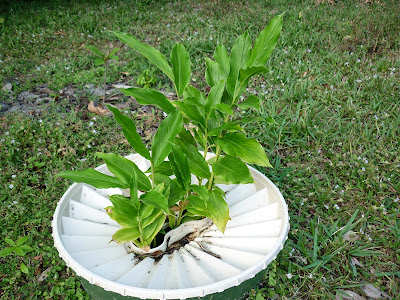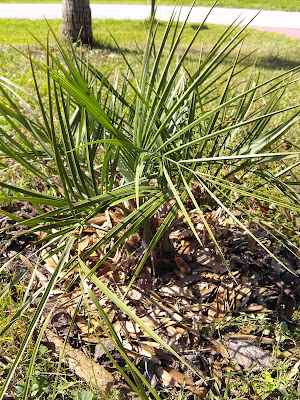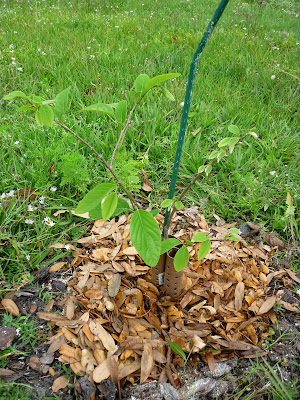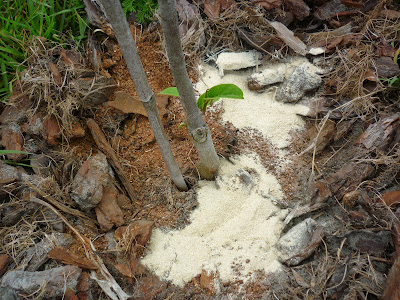51
Tropical Fruit Discussion / Spring 2014 Yard Update and Waterboxx results
« on: April 14, 2014, 01:52:32 AM »
Everything is going well so far I only lost a few plants since last update. A lucuma did not make it as well as a goji berry (which mistakenly got mowed over). I have a unique situation, since the irrigation system is broken needs to be setup to all the plants and attended water is sparse between (relying on my parents to attempt it during drought periods).
Remarkably, I have gotten very high survival rates for all the plants. This is due to steady rains during the months and strategic planting of plants due to drought tolerance levels. For example I have Jaboticaba plants directly down stream from the gutters and in semi shaded areas. I have also been taking advantage of using Coconut palm fiber and oak leaves as mulch.
Another thing that has worked out excellent, is using Waterboxxes. I am very impressed with the results, and will be purchasing another 10 soon. The waterboxxes are reusable and excellent for establishing sprouted seedlings, or seedling plants directly in the ground. I believe the best way to get a plant established by seed is directly sowing in the ground, with this waterboxx it makes that possible for me.
I have so far obtained a 100% survival rate for all the plants in the waterboxx. If you go to the groasis website you can learn about how it works (I rather not try to rephrase, when you can get all the videos and reading material there). Anyway below is the photos of the yard and results of the waterboxx.
This is a Eugenia neonitida directly sown as a small seedling about 6 months after using the waterboxx.

This is the E. neonitida with the waterboxx removed later that day and then fertilized with fish bone meal and mulched with dried oak leaves.

Another E. neonitida with the box removed.

I also took extra steps and surrounded the newly unboxed seedlings with black 40% shade cloth. I will leave this on until the end of the year and then take off in the winter (I did not do this with all plants with the waterboxx off, but wanted to ease the seedlings into non irrigated conditions (the science behind waterboxx is it helps the roots of the plant get down to the groundwater table, considering the location I believe the depth to ground water is about 8-12 feet down.
Another example of Aframomum sp., this was started as a small 4 inch seedling. After about 6 months

Aframomum sp. with box removed, no shade cloth for this one. Since the storage rhizomes and partly shaded area give me more comfort on survival. I think a lot of these fruit species are pretty tough once they find their way to the ground water. I placed a generous oak leaf mulch, another nice thing about the waterboxx, is after removal depending how it was placed it usually creates a 1/2 to 1 inch indentation (which is perfect for water collection for the plant).

I also established an Alma seedling, box was removed and mulched as well after.

Here is a Parkia bigolosa (I believe the leaves defoliated during the winter period, it seems like new leaves are coming in). Box was also removed and mulched.

Eugenia calycina (Leaving the box on longer with this one, going to wait until the leaves emerge above the box).

Two Peach Palm seedlings in the waterboxx. Keeping the box on until the seedlings grow above to the sun line. I am not sure what to do in the long term... I may let it clump since I hear Peach Palm is a clumping palm.

One of the many coconut palms producing nicely after fertilizing with slow release steak fertilizer. I also fertilized again with fish bone meal and cotton seed meal, azomite. The coconuts have been larger on average and much sweeter, excellent coconut water.

Pindo Palm, put on a little growth. I recently fertilized and remulched.

This is a unknown jabo, which was bought from wellspring a while ago. I recently cleaned up the surrounding grass and remulched shortly after photo.

I believe this is a physical graffiti dragon fruit growing up a king palm (It may be purple haze but I will have to correctly ID when I get a purple haze IDed segment next to it). The rain washed the marker off before I placed a metal tag!

Keitt mango, set a nice crop of mangoes. However anthracnose has seemed to zap some of the small fruit, not a major loss (I should still have at least 15-20 big mangoes).
Lemon Zest mango, this is doing extremely well and seems to be fast growing and disease resistant.

LZ fruit forming, going to let it hold a couple.

Glenn mango, no fruit on this but thats ok (want it to put some more size on it).

Okrung seedling, doing very well, looks extremely healthy. I chopped off about 6-8 inches of top growth after the photo, hoping I can spur more bushy form.

Cogshall, staying nice and compact. Recently cleaned up the surrounding area and remulched nicely.

Dream atemoya after remulch. Tree is looking great .
.

Process done on most trees, fertilizer is cotton seed meal, fish bone meal, and azomite placed around tree then mixed into soil lightly I tried to space it off the trunk after applying to the ground (fertilizer burn should b avoided due to the lower concentrated more organic source of fertilizer used). Finished with a nice layer of oak mulch.

Sabara Jabo, located about 2 ft from the gutter . Its about 6 ft from the house wall (hopefully not to close any input would be greatly appreciated, plan was to selectively prune branches away from home and toward the west side).
. Its about 6 ft from the house wall (hopefully not to close any input would be greatly appreciated, plan was to selectively prune branches away from home and toward the west side).

Ross Sapote, starting to put out some new growth

Tropical Apricot, this is doing excellent. Tough as nails and one of the fastest growers so far. May actually prune this back soon, since I want to keep it fairly compact.

Thats all for now, I will try to add some more in the next day or so.
Remarkably, I have gotten very high survival rates for all the plants. This is due to steady rains during the months and strategic planting of plants due to drought tolerance levels. For example I have Jaboticaba plants directly down stream from the gutters and in semi shaded areas. I have also been taking advantage of using Coconut palm fiber and oak leaves as mulch.
Another thing that has worked out excellent, is using Waterboxxes. I am very impressed with the results, and will be purchasing another 10 soon. The waterboxxes are reusable and excellent for establishing sprouted seedlings, or seedling plants directly in the ground. I believe the best way to get a plant established by seed is directly sowing in the ground, with this waterboxx it makes that possible for me.
I have so far obtained a 100% survival rate for all the plants in the waterboxx. If you go to the groasis website you can learn about how it works (I rather not try to rephrase, when you can get all the videos and reading material there). Anyway below is the photos of the yard and results of the waterboxx.
This is a Eugenia neonitida directly sown as a small seedling about 6 months after using the waterboxx.
This is the E. neonitida with the waterboxx removed later that day and then fertilized with fish bone meal and mulched with dried oak leaves.
Another E. neonitida with the box removed.
I also took extra steps and surrounded the newly unboxed seedlings with black 40% shade cloth. I will leave this on until the end of the year and then take off in the winter (I did not do this with all plants with the waterboxx off, but wanted to ease the seedlings into non irrigated conditions (the science behind waterboxx is it helps the roots of the plant get down to the groundwater table, considering the location I believe the depth to ground water is about 8-12 feet down.
Another example of Aframomum sp., this was started as a small 4 inch seedling. After about 6 months
Aframomum sp. with box removed, no shade cloth for this one. Since the storage rhizomes and partly shaded area give me more comfort on survival. I think a lot of these fruit species are pretty tough once they find their way to the ground water. I placed a generous oak leaf mulch, another nice thing about the waterboxx, is after removal depending how it was placed it usually creates a 1/2 to 1 inch indentation (which is perfect for water collection for the plant).
I also established an Alma seedling, box was removed and mulched as well after.
Here is a Parkia bigolosa (I believe the leaves defoliated during the winter period, it seems like new leaves are coming in). Box was also removed and mulched.
Eugenia calycina (Leaving the box on longer with this one, going to wait until the leaves emerge above the box).
Two Peach Palm seedlings in the waterboxx. Keeping the box on until the seedlings grow above to the sun line. I am not sure what to do in the long term... I may let it clump since I hear Peach Palm is a clumping palm.
One of the many coconut palms producing nicely after fertilizing with slow release steak fertilizer. I also fertilized again with fish bone meal and cotton seed meal, azomite. The coconuts have been larger on average and much sweeter, excellent coconut water.
Pindo Palm, put on a little growth. I recently fertilized and remulched.

This is a unknown jabo, which was bought from wellspring a while ago. I recently cleaned up the surrounding grass and remulched shortly after photo.
I believe this is a physical graffiti dragon fruit growing up a king palm (It may be purple haze but I will have to correctly ID when I get a purple haze IDed segment next to it). The rain washed the marker off before I placed a metal tag!
Keitt mango, set a nice crop of mangoes. However anthracnose has seemed to zap some of the small fruit, not a major loss (I should still have at least 15-20 big mangoes).
Lemon Zest mango, this is doing extremely well and seems to be fast growing and disease resistant.
LZ fruit forming, going to let it hold a couple.
Glenn mango, no fruit on this but thats ok (want it to put some more size on it).
Okrung seedling, doing very well, looks extremely healthy. I chopped off about 6-8 inches of top growth after the photo, hoping I can spur more bushy form.
Cogshall, staying nice and compact. Recently cleaned up the surrounding area and remulched nicely.
Dream atemoya after remulch. Tree is looking great
 .
.Process done on most trees, fertilizer is cotton seed meal, fish bone meal, and azomite placed around tree then mixed into soil lightly I tried to space it off the trunk after applying to the ground (fertilizer burn should b avoided due to the lower concentrated more organic source of fertilizer used). Finished with a nice layer of oak mulch.
Sabara Jabo, located about 2 ft from the gutter
 . Its about 6 ft from the house wall (hopefully not to close any input would be greatly appreciated, plan was to selectively prune branches away from home and toward the west side).
. Its about 6 ft from the house wall (hopefully not to close any input would be greatly appreciated, plan was to selectively prune branches away from home and toward the west side).Ross Sapote, starting to put out some new growth
Tropical Apricot, this is doing excellent. Tough as nails and one of the fastest growers so far. May actually prune this back soon, since I want to keep it fairly compact.
Thats all for now, I will try to add some more in the next day or so.

 . Thanks for any help finding out what it is.
. Thanks for any help finding out what it is.
 . I left out about 15 or so other plants I planted, I forgot to take pics lol.
. I left out about 15 or so other plants I planted, I forgot to take pics lol.



